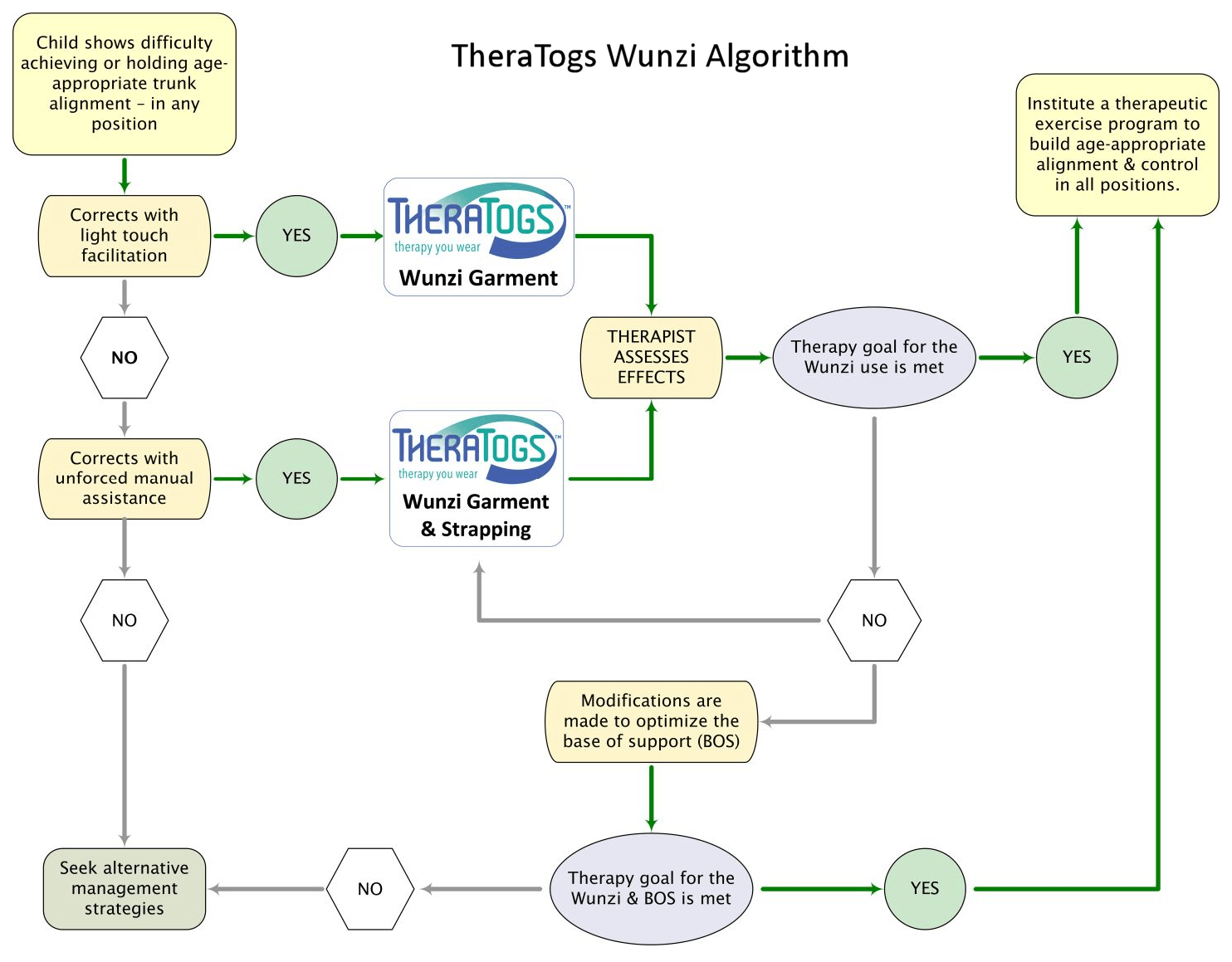How To Choose a TheraTogs System
TheraTogs are assembled in different combinations of components to address similar needs. In general, follow these steps to choose the appropriate TheraTogs for your individual client(s):
Step One: Evaluate your client
Identify rehab management objectives that TheraTogs can be expected to effectively address. Start with any core strength or postural alignment issues, and work outward to the limbs. If the client’s gait is involved, identify any need for foot positioning or orthotic assistance. TheraTogs’ improvements to gait patterns are best achieved when working with the wearer on a flat surface.
Step Two: Measure and record baseline abilities and movement ranges
Use an appropriate standard test (PEDI, GMFM, WeeFIM, etc.) to quantify current metrics, and set rehab objectives accordingly.
Step Three: Confirm your management and intervention targets
Refer to one of our TheraTogs algorithms as needed to help determine an appropriate intervention.

|

|

|
Step Four: Refine your options
Determine the appropriate TheraTogs system based on your client’s indication(s) and your rehab objectives. You can use the chart offered below to map specific indications to the corresponding TheraTogs systems.
TheraTogs by Indication
| For this indication… | Select one of these systems… | ||
| Flexible spinal kyphosis | |||
| Lumbar lordosis | |||
| Hypotonia | |||
| Flexible torso, pelvic, or hip joint malalignments | |||
| Deformity-promoting scapular and UE joint postures | |||
| Shoulder pain due to mal-alignment | |||
| Positioning for osseous LE deformity prevention (torsion abnormalities) in infants and young children | |||
| Post-operative Intrathecal Baclofen pump stabilization | |||
| Sleep disturbances, wakefulness | |||
| For this indication… | Select one of these systems… | |
| Scissoring gait – mild to moderate | ||
| In-toeing, out-toeing, or windblown gait | ||
| Mal-alignment of hip joint | ||
| Flexible foot pronation or supination | ||
| Genu varum or genu valgum | ||
| Knee hyperextension | ||
| For this indication… | Select one of these systems… | |
| Mal-alignment of scapulae, shoulder girdle, or humerous | ||
| ROM deficits in scapulae, shoulder girdle, or humerous | ||
| Shoulder pain or post-fracture discomfort | ||
| Post-surgical weakness or discomfort | ||
| Positioning for osseous UE deformity prevention (torsion deficits) in infants and young children | ||
| Elbow flexion or extension deviations | ||
| Forearm pronation or supination deviations | ||
| Functional thumb or wrist deviations | ||
| For these specific Clinical Objectives… | Select these systems… | |
| Flexion and Hip Lateral Rotation Assist | ||
| Hip Abduction control with lateral rotation |
+ Limb Kit |
|
| Hip Extension with Hip Abduction and Lateral Rotation (6 to 24 months) |
+ Limb Kit |
|
| Hip Extension with Hip Abduction and Lateral Rotation (birth to 6 months) | ||
| Iliopsoas Muscle Assist |
+ Limb Kit |
|
| Lumbar Extension with Hip Flexion, Abduction & Lateral Rotation |
+ Limb Kit |
|
| Shorten and Assist Abdominal Muscles: Position and sensory awareness |
|
|
| Spinal Extension Assist (birth to 6 months) | ||
| Spinal Extension Assist w/ abdominal strapping (6 to 24 months) |
+ Limb Kit |
|
| Spinal Flexion | ||
| Spinal Flexion with abdominal assist |
+ Limb Kit |
|
| Stabilize Scapula w/ Upper trunk extension (6 to 24 months) |
+ Limb Kit |
|
| Stabilize Scapula w/ Upper trunk extension (birth to 6 months) |
|
|
TheraTogs Applications by Rehab Objective
- Facilitate Trunk Extension
- Reduce Upper Trunk Rotation
- Facilitate Trunk Flexion / Reduce Opisthotonus
- Facilitate Trunk and Hip Extension
- Reduce Pelvic Rotation
- Reduce Excessive Anterior Pelvic Tilt
- Facilitate Increased Lumbar Lordosis and Hip Flexion
- Apply Vertical Compression for Ataxia / Reduce Hip Adductor Dominance
- Facilitate Hip Abduction and Stability / Reduce Scissor Gait
- Facilitate Hip Lateral Rotation
- Facilitate Hip Medial Rotation
- Facilitate Hip Extension
- Reduce Excessive Lateral Leg Rotation
- Reduce Excessive Medial Leg Rotation
- Facilitate Knee Extension
- Reduce Knee Hyperextension
- Facilitate Knee Flexion
- Manage Genu Varum Due to Ligament Laxity
- Manage Genu Valgum Due to Ligament Laxity
- Facilitate infant trunk control
- Facilitate infant neck control and neck strength
- Facilitate sensory input
- Limit excessive trunk motions
- Facilitate alignment of hips and/or shoulders
- Stabilize one or both scapulae
- Facilitate respiration by reducing flexible kyphosis
